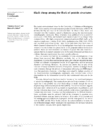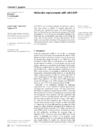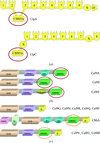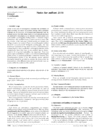issue contents
January 2010 issue

Cover illustration: Pseudo-hexagonal packing arrangement of a collagen model peptide (Pro-Pro-Gly)4-Hyp-Hyp-Gly-(Pro-Pro-Gly)4 (ppg9-OOG_H). The asymmetric unit consists of ABC and DEF molecules (marked by green filled circles). Molecules shown as stick models are directed upwards from the paper, whereas those shown as ball-and-stick models are directed downwards from the paper (p. 88).
editorial
Free 

research papers
Structure determination was successfully carried out using single Laue exposures from a group of lysozyme crystals. The Laue method may be a viable option for collection of one-shot-per-crystal data from microcrystals.
Open  access
access
 access
accessMolProbity structure validation will diagnose most local errors in macromolecular crystal structures and help to guide their correction.
The molecular-replacement program MOLREP is described.
The distribution of the twinning ratio of crystals of bacteriorhodopsin was studied under a variety of in meso crystallization conditions. A condition favouring the growth of untwinned crystals was determined.
The first structure of the family 3b′ CBM derived from the Cel9V glycoside hydrolase of C. thermocellum, which fails to bind crystalline cellulose, is presented.
Monitoring changes in B values using self-interaction chromatography combined with crystallization trials resulted in single straight-edged crystals of light-harvesting complex 1–reaction centre from A. vinosum. The method allows the rapid screening of additives and detergents.
The X-ray structure (at 1.86 Å resolution) of S. typhimurium uridine nucleoside phosphorylase complexed with its inhibitor 2,2′-anhydrouridine and phosphate and potassium ions is reported.
PDB reference: uridine nucleoside phosphorylase, 3fwp
The structure of dihydrodipicolinate reductase from M. tuberculosis has been determined in three different crystal forms as the apo form of the enzyme and as a binary complex with the cofactor NADH. A comparison of the structures reveals a striking domain rotation, which can be rationalized by normal-mode analysis.
The low molecular weight PNP from Schistosoma mansoni is shown to bind adenosine in a similar fashion to that observed for the 6-oxo purine substrates. This important difference with respect to the human enzyme, which is unable to bind adenosine, is explained on the basis of minor details to the active site and the corresponding water structure.
The crystal structure of MK2 bound to TEI-I01800, a pyrazolo[1,5-a]pyrimidine-scaffold inhibitor, showed an α-helical Gly-rich loop. The secondary structure of the Gly-rich loop might be regulated by the ligand structure.
PDB reference: MK2–TEI-I01800 complex, 3a2c
Two crystal modifications of a collagen model peptide with a Hyp-Hyp-Gly sequence in the middle of 27 residues were analyzed at high resolution. Differences between the molecular interactions of these modifications revealed clear preferences for the Hyp(X) puckering.
Open  access
access
 access
accessA toolkit for the characterization of CCD cameras has been developed. Its use has been demonstrated by the characterization of three in-house transmission electron microscopy detectors, yielding statistics such as the number of outliers, the modulation transfer function, the conversion factor, the effective gain and the detective quantum efficiency.
international union of crystallography
Free 



 journal menu
journal menu

































